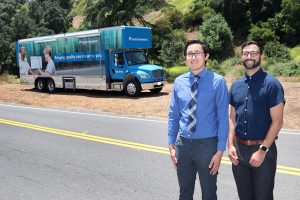Increasing vaccine equity in Southern California
 In addition to bringing isolation and illness to the world, the COVID-19 pandemic spotlighted the health disparities between Southern California communities.
In addition to bringing isolation and illness to the world, the COVID-19 pandemic spotlighted the health disparities between Southern California communities.
Getting COVID-19 vaccines to the neighborhoods where they were most needed was one of the greatest challenges health care providers experienced during the pandemic.
Many teams worked together to address issue
At Kaiser Permanente in Southern California, people rallied to address the issue. Their successful quality improvement implementation study outlining these efforts was published in The Permanente Journal.*
The effort included team members from National Community Health and the Southern California Permanente Medical Group’s regional departments of Complete Care; Equity, Inclusion, and Diversity (EID); and the Department of Research & Evaluation, among others. They were able to align their program with work started by the SCPMG’s EID Department in 2019 that was meant to address disparities in flu vaccination.
“Our work was an effort to highlight the concept of ‘place equity,’ meaning that more of an individual’s health can be attributed to their ZIP code than anything else, and that the inequitable distribution of community resources therefore contributes significantly to health disparities,” said Alexander Martos, DrPH, a managerial consultant and interim director for SCPMG’s EID Department. “We applied this to a real-life crisis during the early pandemic and were able to demonstrate meaningful progress in disparity reduction.”
Research & Evaluation committee stepped up to help
Research & Evaluation formed an EID committee in June 2020 in the wake of the George Floyd murder to increase equity in the workplace and reduce health disparities. By January 2021, when the first COVID-19 vaccines became available to the public, it was clear that some communities with fewer resources were seeing higher rates of illness and death due to COVID-19. Getting vaccines and making them widely available was a challenge in Southern California, as well as across the nation.
The committee reached out to the SCPMG EID Department to partner on efforts on COVID-19 vaccine distribution.
“It was an honor to contribute our expertise in research methodology and dissemination to assist the collaborative efforts of our region to improve access to vaccinations for the underserved,” said research co-author Angel Alem, MPH, MS, a division operations director and EID committee co-leader for Research & Evaluation. “When we had a chance to help with the vaccine equity effort, we didn’t hesitate.”
The disparities in vaccine access and COVID-19 health burdens in the nation in 2021 were largely driven by inequities in socioeconomic factors and policies, practices, and attitudes that can often result in poor health outcomes for minority populations, said Reina Haque, PhD, MPH, a research scientist with Research & Evaluation who was the senior author on the research study.
Hot-spot strategy employed to address inequities
“To address the challenges of inequitable access to the COVID-19 vaccine in Southern California, Kaiser Permanente Southern California applied a community-oriented and geographic strategy aimed at reducing disparities in COVID-19 vaccination by ZIP codes,” Dr. Haque said. This became known as the “hot-spot” strategy.
Together, the members of these groups used analytical tools to systematically assess the risk of COVID-19 in different communities within Kaiser Permanente Southern California’s 670 ZIP codes. The hot-spot methodology produced monthly lists of ZIP codes that required additional health care resources and vaccination strategies. Then the COVID-19 vaccination teams worked with medical centers in the most challenged ZIP codes to get more people vaccinated. Strategies included sending proactive texts, extending vaccination clinic hours, providing in-home vaccinations for homebound patients, and a mobile health vehicle that drove into the neighborhoods with vaccines. Health care providers at the various pop-up clinics and in the mobile health vehicles vaccinated both Kaiser Permanente members and nonmembers.
The strategy was effective in both creating awareness of inequities and guiding vaccination efforts toward the most vulnerable communities, Dr. Haque said.
Strategy success leads to publication and further efforts
By the end of 2021, this hot-spot strategy helped Kaiser Permanente achieve an overall vaccination rate of 81% among all of its Southern California members. Additionally, 2 out of 3 people who received a vaccine through the hot-spot-guided mobile health vehicle were Hispanic or Black. But the work didn’t stop there. This place-based approach to reducing vaccination disparities in underserved communities was quickly adapted to other health disparities, said Dr. Martos.
In 2022, the strategy was rolled out to address disparities in flu vaccination and diabetes control.
“After we had successfully employed this hot-spot vaccination strategy with COVID-19, we were able to refine how we analyzed the data and our approach to the social and economic factors impacting our members,” Dr. Martos said. “We are now in the process of operationalizing these hot spots with our vaccination and proactive care teams and look forward to exploring new health equity opportunities in the future.”
*Swope M et al. Perm J. 2023 Mar 15;27(1):103-112.





